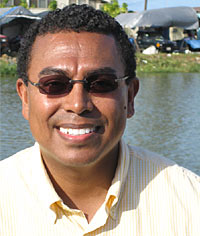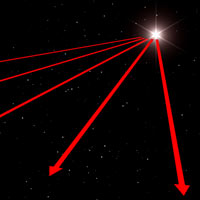

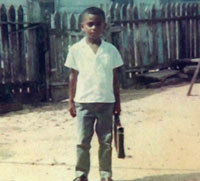
Even at an early age, Petters took life seriously. Here he carries a makeshift briefcase in his hometown of Dangriga, Belize. 
"The first thing you had to do was you had to get muscles," Petters says of his changing priorities when he moved to Brooklyn, New York as a teenager. 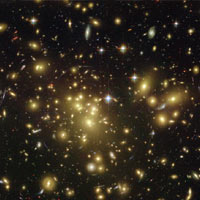
The faint arcs seen in this image by the Hubble Space Telescope are the distorted, "gravitationally lensed" images of galaxies even more distant than the cluster of galaxies seen here, which are already about two billion light-years from Earth. 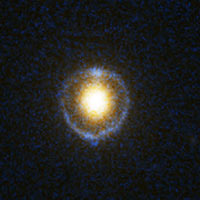
The light of a distant galaxy (blue ring) is deflected around a closer galaxy (white center) that lies directly between the distant galaxy and the Hubble telescope, which took this bulls-eye image. 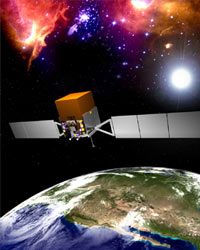
Petters hopes the GLAST spacecraft, seen here in a rendering, will help in the search for a possible fourth spatial dimension via gravitational lensing. 
The Petters Research Institute in Dangriga, Belize, whose goal, says its founder, is to nurture young Belizeans with talent in math and science |
Arlie Petters' personal journey has taken him from a rural village in Belize to the streets of Brooklyn to the ivy-covered walls of academia. Through it all, he has gained a remarkable perspective and maintained a charming sense of humility. In the following interview, get insight into what makes Petters both an accomplished cosmologist and an inspirational mentor. Nature's geometryQ: You have a very organized desk. But there's something else in your office I want to ask about: Why do you have a reclining chair? Arlie Petters: Every day I take time off to meditate. And it's the perfect place for me to go and turn off the engines and just live in the present. Q: How else do you recharge? Petters: I walk through the Duke Gardens and especially go over by the ponds, where I can see reflections of light, where I can see the ducks moving around in the currents, generating ripples in the water. I walk through the trees. I look at the geometry of the leaves. I look at how light falls through the trees and notice there are light rays that have made it through and others that got blocked. I experience the wind blowing on my face. Those are moments in a day that are for my well-being. Q: Hearing you talk about the geometry of the leaves, it sounds like the science doesn't entirely go away. Petters: Well, when I take these walks, I experience the beauty of mathematics and the beauty of nature. I don't try to calculate any equations. I am now an observer of the beauty of geometry in nature. And it's a kind of mediation. Q: I wonder how many people see the geometry in nature! Petters: [laughs] Q: Have you always seen nature through this sort of lens? Petters: In Belize, as a kid, I would just sit out on a pier and look at the shape of the clouds. In Belize, at those latitudes, the sky could be quite grand. Another one of my pleasures was lying down on a soccer field and looking up at the cloudscape. You have breathtaking arrays of clouds and colors in the sky—the variations in blue. I'd just suck it in, as if breathing air. And I think that must be the origin of where my appreciation for the unity and the beauty in nature comes from—those childhood days in Belize. Q: Do you think your experience as an immigrant relates to your career? Petters: When I first came to the U.S., I had this thick Belizean accent. I felt I belonged in a community of African-Americans; I had many friends and so on. At the same time, everyone kept teasing me: "You speak in such a strange way." So as an immigrant, I felt a little like I was in this no-man's-land. And if you look at my work, I touch on pure math, I touch on astrophysics. I'm even doing mathematical finance, right? I do quite a mixture of things. I think of myself, deep in my heart, as a citizen of the world. When you feel you're in no-man's-land, well, you can view it that way, or you can view the glass as half full in that I engage in all these different cultures and a little bit of each comes into me. I prefer to take that more positive view. Q: What has science given you? Petters: Science has given me a firm platform on which to walk. At times in your life you need to feel that there are some certainties in the physical world. If there's uncertainty in your day-to-day physical existence—like the stress that I was experiencing in Brooklyn, where you wonder, "Boy, am I gonna get shot tomorrow? Am I gonna get mugged?"—you need more certainty in your life. Science helped me psychologically to get an anchor like that. Q: What type of questions can science best answer? Petters: You know, a question a kid always asks is "Why?" "Why, why, why, why?" It turns out that science is not good at answering that question. If you keep going down that road in science, to me, you get sucked down a philosophical black hole. Instead, if you ask the question "How?" "How does this work?" Yes, science is a really good tool for addressing that. Bending lightQ: What is gravitational lensing, generally? Petters: Very simply, it is how gravity acts on light. Now, what does that mean? Here's an analogy: If you have light passing through a medium—it could be a pond of water, it could be my glasses—that medium is going to affect it compared to light traveling just in a vacuum. Light may get deflected, it may even be slowed down, and this impact of gravity on the light ray comes under the fancy name gravitational lensing. Q: Most people assume that light in outer space travels in a straight line. Petters: Yes, but one of the profound things in Einstein's theory of gravity is that light no longer has to travel in a straight line. You could think of light now as riding along undulations in space, the same way that a truck traveling through hills and going in valleys, it goes up, it turns, it goes down. A light ray, when it travels in the universe, it's going to ride the currents of gravity. Q: How does this lensing affect our view of objects in the universe? Petters: It may turn them upside down, it may stretch them, and it may even create multiple images of them. Q: Has this actually been observed? Petters: Yes. It was first seen in 1979, and this observation was really profound in that most people were not too sure it would ever be observed. In that case, there were two copies of the same background object. Astronomers could tell that they were the same object by studying the light profile in different wavelengths, and the copies were identical. Q: When did you start work on gravitational lensing? Petters: I was in graduate school. At that time it was known that if you have one star acting as a lens, it will create double images of a background object. And if you have two stars acting as a lens, you'll get three or five images. And I said, "Wow, I would really like to know the answer, if I have n stars"—where n could be a billion or it could be five, right? That problem was so complicated that, when I first looked at it, I said, "There is no way on Earth this is humanly solvable." Q: What did your advisor, [Princeton physicist] David Spergel, say about pursuing this? Petters: One thing I loved about my supervision under Professor Spergel was that he let me roam freely—within limits, of course—but I had a lot of creative freedom. And the idea of pursuing this problem was so appealing that he let me try and chase it down. Q: Why would you tackle something so tough? Petters: Advancing science happens through solving problems that are blocking us from looking further on. It's that obsession that drove me. Q: So you began working on this seemingly impossible problem. How did you make a breakthrough? Petters: One day I was on an Amtrak ride to go to see my second advisor, Bertram Kostant, who is a pure mathematician at MIT, and a thought occurred to me. (Why it occurred at that moment, I have no idea, but I do know that an Amtrak ride is excellent for working.) I was thinking about this problem in the wrong way: I wrote down the equations, and they were extremely intimidating, extremely complicated, and I had no idea where to begin to solve them. And the epiphany was to realize, "I need to count the solutions," which is different from trying to solve the equation. Q: How did that epiphany help? Petters: Well, among the body of pure mathematics I had been learning, there was something called Morse Theory. I realized, "Hey, if I could somehow establish that the number of solutions to this equation is the same as the number of peaks and valleys in a sort of mountainous terrain" (I know that sounds strange, right?) "I would be in a better place, because it's a bit easier to see peaks and valleys than to get inside this complicated equation." I said, "I know I can make that connection." And it turns out that you can. Cosmic mysteriesQ: Why is math critical for understanding the universe? Petters: Honestly, I don't know the complete answer, but I can tell you this: There are certain acts of faith you engage in when you're pursuing physical science. One of them is you assume that the physical world, it's describable, right? And the second thing you assume is that, at the end of the day, it will be describable in mathematical terms that allow you to make precise predictions that can be tested. That's an act of faith, and it has been going pretty well so far. Q: Can gravitational lensing address big mysteries about the universe? Petters: Well, one of the deep mysteries about our universe is that about 96 percent of it, we don't really know what it is. We have various theories about it. In the popular press, we hear about "dark matter." If it truly exists, it will have a gravitational field. And if it has a gravitational field, then gravitational lensing is going to pick up the signature of this dark matter. Q: Can gravitational lensing also address whether there are extra dimensions? Petters: Yes. We are all familiar with space having length, width, and height. Well, there are speculations that there may be extra dimensions to space. Recently, Chuck Keeton of Rutgers University and I, we wrote a paper that's a bit radical. We predicted, essentially, that the presence of a fourth dimension in space would give you a wiggle in the light profile in certain lensing situations. Our hope is that this will be observable in the near future by the GLAST [Gamma Ray Large Area Space Telescope] satellite that's slated to be launched by NASA in [August] 2007. [Learn more about Keeton and Petters' hypothesis in Tiny Black Holes.] Q: Do you think there is a fourth dimension? Petters: I prefer to say, currently, I am on the fence. But it would be really a profound intellectual shift in our understanding of the physical world if this wiggle is actually observed. The next generationQ: Why is it important for you to be a mentor? Petters: As an African-American and an immigrant, the journey that I have taken in my life—and millions of others like myself are currently taking—it's a deep and challenging experience. By "deep," I mean a lot of it you can't even articulate with words. And it's extremely important to pass on knowledge to those that are coming behind you. So when I look at my 15 years of experience in academia, I just want to take everything that I have learned, technically and in life experience, and pass that on to everyone in my research group. I have navigated a lot of mines and even gotten hurt in the process. And if I don't share that with the children coming behind me, I mean, how could I live with myself? Q: Are African-Americans and other minorities adequately represented in your fields? Petters: We have a very long way to go in terms of representation of African-Americans, Hispanics, Latinos, and women in the physical sciences and mathematics. In mathematics, for example, you have, on average, about just one percent of Ph.D.s going to African-Americans. Q: Each year. Petters: Each year. And that is dismal. When you think about how the modern world is run essentially on science and technology—how it pushes ahead economic growth, innovation—it has an enormous impact on our communities. We don't become self-sufficient. We are not able to manage the technologies that will help our own communities. And that is a significant social issue that I personally will do all I can to assist in addressing. Q: Where did the idea for the Petters Research Institute come from? Petters: About a year and a half ago a colleague of mine at Princeton contacted me about being on a committee sponsored by the World Bank and the Nelson Mandela Foundation. The goal of this committee is to help lay out the architecture for four world-class scientific institutes across Africa. He wanted me to help with designing the mathematics curriculum. And I couldn't resist that. I remember at our first meeting at the World Bank in D.C. listening to the struggles that sub-Saharan Africa is going through, the economic struggles, not just civil unrest and so on. And the profound question on the table was this: How can we turn around sub-Saharan Africa economically? And the consensus view was investment in science and technology and spawning innovation from such an investment. Look at India. You're seeing it happening today in China. Of course, it happened in Taiwan. And there are many examples of countries that were extremely poor, especially right after World War II, that turned around through a profound investment in their human resources, particularly in science, technology, engineering, and mathematics. Q: So this experience helped spark the idea for your institute? Petters: Yes. It was just natural to say, "I need to bring this back to Belize." That was behind the Petters Research Institute, an institute named not after me but in honor of my family. Q: Where did you get the money to build it? Petters: At the time, my wife and I were planning to build a vacation home in Belize. And I said, "Why don't we make the building much bigger and let that be the first location of this institute?" We funded it out of our pockets. The Petters InstituteQ: What is the mission of the Petters Institute? Petters: The core mission is to promote excellence in mathematics, science, technology, and also synergies with the creation of businesses, and hopefully to have all that lead to national development. Q: How can it tackle something so big? Petters: The institute would serve as a catalyst and, in many ways, as a think tank that can lay out the strategic vision. We are especially well poised to do that not only because of the expertise that we have access to, but also we are nonprofit and politically neutral. Q: Are you working with the government? Petters: The institute has always had a relationship with the government of Belize. For instance, we are currently working on a tax bill to bring in revenues from international businesses registered in Belize, revenues that would be directed to education and begin to turn the ship in a direction that would lead to better economic growth and a higher standard of living for our citizens. Q: What's the goal of your summer academy? Petters: The summer academy aims to expose kids to science very early and to do it in a way that, first, is enjoyable, and then for them to see how it's relevant to everyday life. We do that not only, say, with physics or chemistry, but also with mathematics. Most kids in the developing world are unaware of the degree to which mathematics is in our everyday lives. Q: How were the students chosen? Petters: We paid very careful attention to excellence. That excellence doesn't have to mean necessarily a high GPA, but promise, right? You can have a poor kid who isn't doing as well in school in large measure due to the home conditions. But that kid is driven. So we made sure that we had a nice cross-section of the Belizean population. We also had students from the U.S., Belizean Americans living in the U.S. who usually come back to Belize in the summers. We are also hoping to have African-Americans and other kids who want to have an international experience come to Belize and do science in this cross-cultural environment. Q: How did you measure success? Petters: I'm a very old-fashioned, down-to-earth, practical kind of guy in the sense that, first, I want an academic measure. The students were given tests or drills to show mastery of content. This happened particularly in mathematics and in scientific reasoning. And then on top of that, they had projects to do. Each student did a poster, and in some cases we had small groups do a poster. And we evaluated them in terms of other things: How well did they explain the ideas? Did they take leadership roles? How were they at getting up and talking to a large group? We also had a class on language and a class in poetry, and we really tried to evaluate the students in all those categories. And then we had pedagogical evaluations more from a psychological point of view that had to do with motivation, self-efficacy: How confident are you in mathematics? Do you see yourself as capable of being a scientist? Q: What were the results? Petters: We had measures that were called "gains," and they just went off the scale. It was out of five, and they were between four and five. Q: How did the students' accomplishments make you feel? Petters: The last day of the summer academy, when all the posters were up on the walls, and adults were around, and I looked at the kids explaining their posters, and I looked at the light in their eyes and their new appreciation for mathematics and scientific reasoning—[he pauses]—words cannot describe it. But it told me that, with this seed, you can surely transform a developing country into a developed one. Human beings are amazing. Q: Do you see yourself in these children? Petters: Yes I do! [laughs] I see myself in all these children. Undeserved graceQ: You once used the phrase "undeserved grace" in talking about everything that has happened to you. Why do you choose to frame it this way? Petters: I believe that I'm blessed to be alive, to experience the process of life, and to experience it with good health and in a manner where I can give back to others, touch the lives of others. At the deepest level I feel that my life doesn't belong to me, right? This is a gift from God. And I'm a vehicle. And that's how I process it in my philosophical paradigm. An orientation like that, it gives you humility. Q: You've accomplished so much. And I know you've got a lot more in you. But what are you most proud of so far? Petters: What I am most proud of is actually very simple and very humble. If I can get a child to be charged up and to believe in himself, to believe in herself—that they can do great things in life—whenever I see that I've accomplished that, have had that spark go off in a child, those are the things that I am most proud of. Q: You live for that moment. Petters: I live for that moment. Q: Just one more thing: tell me about the National Academies honor. Petters: In February [2006], I was honored by the National Academies, including the National Academy of Sciences, National Academy of Engineering, and the Institute of Medicine. They have a portrait gallery of distinguished African-Americans in the physical sciences. And I was really honored to have been selected to be among that portrait collection. In many ways, it highlights the hard work and the struggle and the love that you give back to those coming behind you. Q: Do you remember your reaction when you found out? Petters: [laughs] I was beside myself. I was totally beside
myself. And, um, in the next breath, immediately humbled by it. Because I
realized, it's bigger than me. It doesn't belong to me; it belongs to millions
of people.
|
“I think of myself, deep in my heart, as a citizen of the world.” “There are certain acts of faith you engage in when you're pursuing physical science.” “We have a very long way to go in terms of representation of African-Americans, Hispanics, Latinos, and women in the physical sciences and mathematics.” “With this seed, you can surely transform a developing country into a developed one.” |
|||||||||
|
Interview conducted in November 2006 by Carla Denly, producer of the NOVA scienceNOW segment "Profile: Arlie Petters," and edited by Susan K. Lewis, editor of NOVA online |
|||||||||||
|
© | Created July 2007 |
|||||||||||
